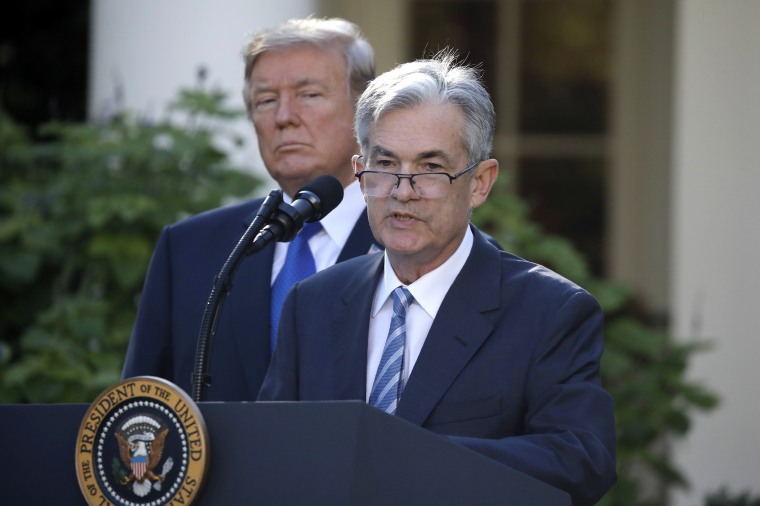President Donald Trump has repeatedly needled the Federal Reserve, taunting Chairman Jerome Powell and lambasting the central bank's monetary policy strategy — but he is not the first commander in chief to pressure the Fed.
"We don’t have a Fed that knows what it’s doing," Trump said Friday. The economy "would be like a rocket ship" if the Fed were to cut rates, the president told reporters at the White House. His comments were the latest in a string of sharp criticisms aimed at the nation's central bank and, specifically, at Powell, whom Trump has reportedly tried to demote or fire.
"Every president wants to influence the Fed," Kathleen Day, a lecturer at the Johns Hopkins Carey School of Business, said.
President Lyndon B. Johnson was so consumed with the effect of the Vietnam War on the budget that he reportedly "pushed Fed Chairman Bill Martin up against a wall," said Brigid Harrison, a professor of political science and law at Montclair State University in New Jersey. "This was a physical threat in order to produce an outcome for the American economy."
"Many of the same things, including threats of firing Fed chairmen, is not really new," Peter Earle, a research fellow at the American Institute for Economic Research, said. "Trump just happens to be louder about it and says it while looking into the TV camera."
The first time a president tried to push the Fed into taking specific action was in the 1920s, when President Herbert Hoover understood there was too much speculation on Wall Street "but didn't know what to do about it," Day said.
Hoover tried to make the Fed raise the interest rate to prevent overheating — but the independent agency chose instead to slash rates, which led to more borrowing as credit became easier to come by. Eventually, the market seized up, resulting in the stock market crash of 1929. When Hoover pressured the Fed to lower rates to initiate a recovery — and save his presidency — the Fed then raised them, which froze borrowing and plunged the country into the Great Depression.
While the Fed learned a lot from the experience, that was not the end of presidents trying to get interest rate decisions that would help their policies and re-election prospects.
Trump has wanted to use political loyalists to push the Fed from inside to keep interest rates low, likely in a bid to boost the economy in advance of the 2020 election. And he's been disappointed multiple times. Now he's hoping his nomination of Judy Shelton and Christopher Waller for the board of governors does the trick. His most recent attempts to nominate Herman Cain and Stephen Moore were controversial and poorly received on Capitol Hill.
Shelton has already said that the Fed should lower rates, and Waller is currently director of research for St. Louis Federal Reserve Bank President James Bullard, who has been a supporter of lower rates.
After World War II, President Harry Truman "went to war with the Fed" to get what he wanted, said Sarah Binder, a professor of political science at George Washington University and a senior fellow at the Brookings Institution. "There was no norm that presidents had to stay mum about what the Fed was doing."
President Richard Nixon had Fed Chairman Arthur Burns to the Oval Office multiple times, in an attempt to have the latter adopt a monetary policy that would improve short-term employment — even if it meant longer-term economic costs — because it would help his re-election prospects, as tape recordings eventually showed.
President John F. Kennedy tried to get the results he desired through regular meetings that included Fed Chairman William McChesney Martin Jr., in which Kennedy was apparently "not shy about telling Capitol Hill and Martin what he wanted them to do on rates," Binder said.
Former Fed Chairman Paul Volcker wrote in his memoir that President Ronald Reagan came to him trying to keep him from raising rates.
However, over the next decade, the situation changed.
"From the Clinton administration in 1993 through the Obama administration, there's been the norm that presidents won't put pressure on the Fed," Day said.
By and large, the organization has indeed remained fairly insulated from direct political manipulation. One reason is inherent in the job it performs. "The Federal Reserve has an extremely difficult job in terms of using monetary policy to guide achieve economic goals," said Kevin Jacques, a professor of finance at Baldwin Wallace University and former senior economist with the Treasury Department. The lag between when events happen and data is available to analyze, and the time it takes for monetary decisions to have an impact, slows response. "The effect is indirect and may take a considerable period of time — in some cases more than a year — to have its full economic effect," he said.
Then there is the structure of the Fed. With its overlapping 14-year terms, it would take until late in a second term for a president to appoint a majority of the board. "There is structure that insulates them to almost a greater extent than any other entity, with the possible exception of Supreme Court appointees and the director of the FBI," Harrison said.
Still, that doesn't mean presidents will stop pushing the Fed to make the numbers good for the next election. And that in itself can help keep the central bank maintain an independent stance.
"Publicly pressuring the Fed may not lead to the desired results, because there is a certain degree of pride the Fed takes in being an independent agency," Harrison said.
From appearances, the current administration will continue helping the agency to strengthen that resolve.
